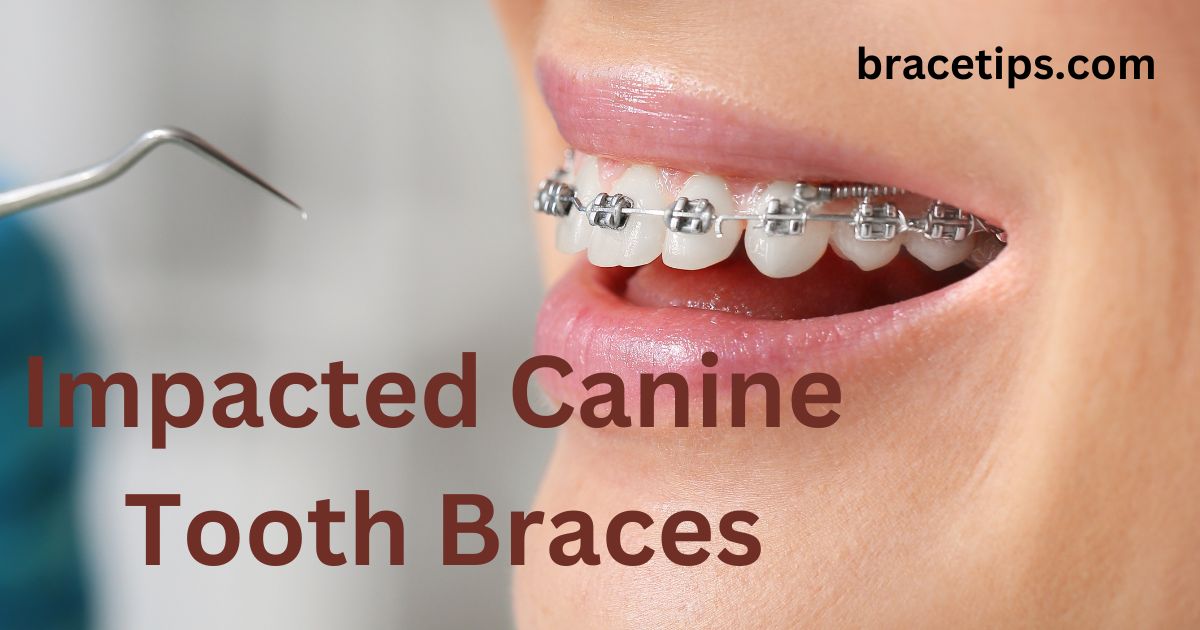Impacted Canine Tooth Braces
Impacted canine teeth can be a common dental issue, where the canine teeth do not emerge properly and become stuck. This condition can lead to various complications, affecting not only the oral health but also overall well-being. The proper alignment of canine teeth is crucial for not only a radiant smile but also for the overall functionality of the oral cavity. In this detailed guide, we will delve into the world of impacted canine tooth braces, exploring what they are, why treatment is essential, the causes behind impacted canines, early recognition, surgical interventions, treatment options in Crystal Lake, the different types of impacted teeth, the consequences of neglect, and the significance of braces in ensuring proper functionality.
What is an Impacted Canine Tooth?
Impacted canine tooth braces are orthodontic devices designed to address the misalignment and improper eruption of canine tooth. These braces play a crucial role in guiding impacted canines into their correct positions, restoring proper dental function and enhancing overall oral aesthetics. An impacted canine tooth refers to a condition where the canine, or cuspid tooth, fails to erupt properly into its designated position in the dental arch. The canine teeth are vital for a balanced and functional bite, contributing to both aesthetics and effective chewing.
Why Treat an Impacted Tooth?
Ensuring Aesthetic Harmony
One primary reason to treat an impacted canine tooth is to maintain the aesthetics of a person’s smile. The canine teeth play a prominent role in the appearance of the upper arch, and their proper alignment contributes significantly to a pleasing smile.
Functional Considerations
Beyond aesthetics, treating an impacted canine is crucial for ensuring proper oral function. Canine teeth are essential for biting and tearing food, contributing to effective chewing and digestion.
What Causes an Impacted Canine?
Genetic factors, overcrowded teeth, and abnormal growth patterns can contribute to the impaction. Early detection plays a pivotal role in addressing the issue effectively. The root causes of impacted canines is essential for both prevention and effective treatment. Several factors contribute to this condition:
Genetic Factors
Genetics play a significant role in dental development. If a family has a history of impacted canines, there is a higher likelihood of the condition occurring in subsequent generations.
Insufficient Space
Crowding in the dental arch can impede the proper eruption of canine teeth. This lack of space can be a result of various factors, including retained baby teeth or an overcrowded dental arch.
Abnormal Tooth Development
Sometimes, the canine tooth may develop abnormally, leading to its improper positioning in the dental arch. This can be attributed to genetic mutations or developmental issues during tooth formation.
Early Recognition of Impacted Tooth is Key to Successful Treatment
Early detection of an impacted canine is crucial for successful treatment. Orthodontic evaluations during childhood and adolescence can help identify potential issues before they escalate. Common signs of an impacted canine include delayed eruption, unusual tooth positioning, and persistent baby teeth. The sooner an impacted canine is identified, the more successful the treatment is likely to be. Regular dental check-ups and early orthodontic evaluations can aid in the timely detection of potential issues, allowing for proactive intervention.
Impacted Canine Tooth Surgery
In cases where early intervention is not possible, or if the impacted canine is causing significant issues, surgical procedures may be recommended. Surgery aims to expose the impacted tooth and guide it into its correct position in the dental arch. Impacted canine tooth surgery becomes a viable option. This section will delve into the surgical procedures involved, discussing their intricacies and recovery processes.
Importance of Addressing Impacted Canine Tooth
Addressing impacted canine teeth is crucial for preventing further dental problems and ensuring proper oral function. Ignoring this issue may lead to misalignment, pain, and difficulties in biting or chewing.
Diagnosis and Assessment
Dentists use various diagnostic tools like X-rays to assess the position of canine teeth. A comprehensive examination helps in determining the best course of action for treatment.
Traditional Treatment Approaches
Traditional approaches to managing impacted canine teeth include extraction or surgical exposure. While effective, these methods may have limitations, leading to the exploration of alternative solutions.
Role of Braces in Addressing Impacted Canine Tooth
Braces have emerged as a viable option for correcting the alignment of impacted canine teeth. Their effectiveness lies in gradually guiding the teeth into their proper positions.
Types of Braces for Impacted Canine Tooth
Several types of braces are available, each with its advantages. These include traditional metal braces, ceramic braces, and invisible aligners. Choosing the right type depends on individual preferences and treatment needs. There are various types of impacted teeth, each requiring specific approaches to treatment. From canines to molars, understanding the distinctions is vital for developing tailored treatment plans.
Benefits and Risks of Using Braces
Braces not only enhance the aesthetics of the smile but also improve oral function. However, like any dental procedure, there are associated risks, including discomfort and the need for regular adjustments.
Choosing the Right Braces
Consulting with an orthodontist helps in determining the most suitable braces for impacted canine teeth. Factors such as severity, lifestyle, and aesthetic preferences play a role in the decision-making process.
Treatment for Impacted Canines in Crystal Lake
For those seeking treatment in Crystal Lake, this section will outline the available options and resources. Crystal Lake residents can gain insights into local dental professionals, treatment facilities, and the supportive community that plays a role in the journey to correct impacted canine teeth.
Types of Impacted Tooth
Not all impacted teeth are the same. This section will explore the various types of impacted teeth, shedding light on the specific challenges and considerations associated with each type. Understanding these distinctions is vital for tailoring effective treatment plans.
Consequences of Neglecting Impacted Tooth
Neglecting an impacted tooth can lead to a cascade of oral health problems. This section will outline the potential consequences, emphasizing the importance of seeking timely intervention. Neglecting impacted canine tooth can lead to a range of complications, affecting oral health and overall well-being. From increased risk of infections to potential damage to surrounding teeth, this section will detail the consequences of neglect and underscore the importance of timely intervention.
Receiving Braces for Impacted Canine Tooth
Braces are often the go-to solution for aligning impacted canines. This section will explore the different types of braces available, detailing their effectiveness and considerations for patients. Braces are a common orthodontic solution for impacted canine teeth. This section will delve into the process of receiving braces, the different types available, and what individuals can expect during the course of treatment. Addressing common concerns and dispelling myths will be a focal point.
Treatment for Impacted Canines in Crystal Lake
For residents of Crystal Lake, this section will provide insights into the local resources available for treating impacted canines. From specialized orthodontic clinics to experienced surgeons, understanding the local landscape is crucial for those seeking intervention.
Ensure Impacted Canine Tooth Properly Function
Beyond aesthetics, ensuring that an impacted canine tooth functions properly is paramount. This section will discuss post-treatment care, including follow-up appointments, maintenance routines, and lifestyle adjustments. Beyond aesthetics, ensuring that impacted canine teeth function properly is essential for overall oral health. This section will explore the importance of bite alignment, jaw function, and how braces contribute to the restoration of proper dental functionality.
The Process of Getting Impacted Canine Tooth Braces
The process of getting braces for impacted canine teeth involves initial consultations, dental impressions, and the fitting of the braces. Regular follow-ups ensure the progress of the treatment.
Tips for Care and Maintenance
Proper care and maintenance of braces are essential for achieving optimal results. This includes maintaining good oral hygiene, avoiding certain foods, and attending scheduled appointments for adjustments.
Success Stories and Patient Experiences
Sharing success stories and patient experiences can inspire those considering impacted canine tooth braces. Real-life examples provide insights into the journey and highlight the positive outcomes.
Calculations
The financial aspects of impacted canine tooth treatment is crucial. This section will explore the potential costs associated with braces, surgery, and post-treatment care. Clear explanations and insights into insurance coverage will empower individuals to make informed decisions.
FAQ Section
Q: How long does the treatment with impacted canine tooth braces usually take?
A: The duration varies but typically ranges from 12 to 24 months, depending on the severity of the case.
Q: Are there any dietary restrictions with braces for impacted canine teeth?
A: Yes, it’s advisable to avoid sticky and hard foods that may damage the braces.
Q: Do braces for impacted canine teeth hurt?
A: Initially, there might be discomfort, but it is temporary. Orthodontists provide solutions to manage any pain.
Q: Can adults get braces for impacted canine teeth?
A: Absolutely, braces are effective for adults as well, and there are discreet options available.
Q: Is insurance coverage available for impacted canine tooth braces?
A: Coverage varies, so it’s recommended to check with the insurance provider for details.
Q: What are impacted canine tooth braces?
A: Impacted canine tooth braces are orthodontic devices designed to address misalignment and improper eruption of canine teeth. They help guide impacted canines into their correct positions, promoting proper dental function and aesthetics.
Q: Why should I treat an impacted tooth?
A: Treating impacted teeth is crucial to prevent issues such as misalignment, oral discomfort, and potential damage to surrounding teeth. Proper treatment can improve oral health, overall well-being, and enhance aesthetics.
Q: What causes an impacted canine?
A: Impacted canines can result from genetic factors, insufficient space in the dental arch, or abnormal tooth development. Understanding these causes is essential for personalized treatment approaches.
Q: How can I recognize an impacted tooth early?
A: Regular dental check-ups and X-rays play a vital role in early detection. Your dentist can identify potential issues before they escalate, allowing for timely intervention and successful treatment.
Q: Is surgery always required for impacted canines?
A: While not always necessary, severe cases of impacted canines may require surgical intervention. The decision depends on factors such as the degree of impaction and individual circumstances.
Q: What types of surgery are involved in treating impacted canines?
A: Surgical procedures may include exposure and bonding, extraction of baby teeth hindering eruption, or orthodontic surgery. Your dentist will determine the most suitable approach based on your specific case.
Conclusion
Addressing impacted canine teeth through braces is a transformative journey that goes beyond aesthetics. It positively impacts oral health, functionality, and overall confidence. If you’re considering this treatment, consult with an orthodontist to explore the best options tailored to your needs. Dealing with impacted canine teeth requires a multidimensional approach from early detection to tailored treatments and diligent post-care. This comprehensive guide aims to equip readers with the knowledge needed to navigate the complexities of impacted canine tooth braces, ensuring a healthy and radiant smile for years to come. From understanding the root causes to exploring treatment options and the importance of post-treatment care, this comprehensive guide aims to provide valuable insights and support for individuals navigating the path to improved oral health and a confident smile. Remember, early recognition and proactive treatment are key to a successful outcome.

